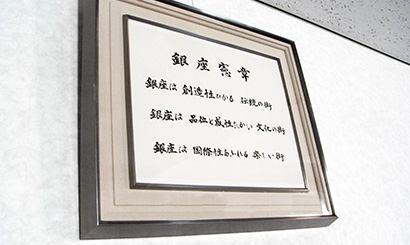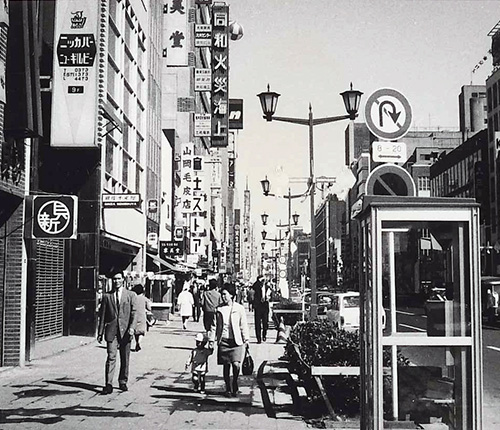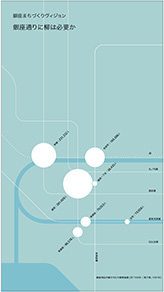The Direction of Machidukuri “Community Building” in Ginza
The Ginza Charter
Established in 1984 by the Ginza Street Association, the Ginza Charter displayed in the meeting room has always served as a guiding principle for the people of Ginza. It proclaims:

- Ginza is a town where creativity shines through tradition.
- Ginza is a town of dignity and refined sensibility in culture.
- Ginza is a fun, international city.
History of Ginza Town Development

Ginza first appeared on the stage of history with the construction of a Western-style tiled street in 1872 (Meiji 5). Ever since, Ginza has taken pride in being at the forefront of progress—believing that continuously leading change is, in itself, a tradition. This rapid development was driven by merchants, workers, residents, and visitors alike.
Even after being devastated by earthquakes and wartime bombing, Ginza consistently set the pace for recovery, with discussions and collective efforts that transformed it into a commercial district even more vibrant than before. Historical research has revealed that from the Meiji and Taisho eras onward, proactive study groups of local citizens have held discussions that led to the innovative urban proposals we see today.
In 2006, in accordance with Chuo Ward’s Urban Development Guidelines, the Ginza Design Council was established by appointment of the Chuo Ward Mayor. This provided a forum for dialogue on the design of Ginza’s streetscape with new developers. Although the system was initially intended for projects mandated by the guidelines, many businesses have voluntarily engaged in discussions regarding their advertising or façade changes, aiming for designs that contribute to the shared prosperity of Ginza.
The spirit behind this approach is not to impose rigid rules or predetermined answers. Rather, it is to engage in open dialogue with developers and creative professionals about what constitutes “Ginza-ness” at any given time—and to make decisions that are responsive to current conditions. This flexible, consensus-based process is at the heart of Ginza’s decision-making.
Over the years, through hundreds of design consultations, various challenges have emerged. In response, and with changes in social conditions, the council has continually worked on a common direction for Ginza’s urban design.
The Spirit of Ginza Town Development

Innovation Over Tradition
In 1872, enterprising merchants from across Japan flocked to Ginza in search of Western innovations. They introduced new goods and business practices that were born right here in Ginza. Soon, newspapers and cultural figures gathered, turning Ginza into a cutting-edge commercial center. Today, Ginza remains a place where culture is born and entrepreneurial spirit thrives—a city that welcomes new ideas rather than clinging solely to historical traditions. Its ability to continuously innovate is, in fact, its greatest tradition.
Balancing Urban Bustle and Dignity
Ginza is a place where seemingly opposing elements—vibrancy and refinement, the extraordinary and the everyday, global brands and long-established names, wide avenues and narrow alleys—coexist harmoniously. By accepting and learning from these differences, Ginza has grown richer in character. The mutual respect and cultivation of each entity’s unique qualities represent one of Ginza’s most valuable shared assets.
Coexistence and Mutual Prosperity; The Individual and the Collective
What has sustained Ginza through changing times is trust. The mutual trust between visitors and businesses—and even among businesses themselves—is the cornerstone of Ginza’s identity. Rather than a single winner emerging, longestablished businesses, new enterprises, and large commercial facilities all work with a spirit of “we’re all in this together.” By continuously creating individual value within this interconnected framework, Ginza as a shared asset is nurtured and its overall market potential expanded.
Decisions Made Through Dialogue, Reflecting the Present and Created by People
Ginza is not governed by top-down mandates; instead, the many independent merchants of the district come together to discuss and decide what Ginza should be. Although this process may be time-consuming, it ensures that the collective vision for Ginza remains aligned with its values. Instead of fixed rules, decisions are made through accumulated personal values and open dialogue—one issue at a time.
Ginza Urban Stroll, Town Designed for Enjoyable Walking
Since the Edo period, the basic urban layout of Ginza has remained largely unchanged. The varied network of streets forms a fabric reminiscent of a woven textile, creating a town that is comfortable and enjoyable to walk in. With every street lined with shops—none hidden on the back side—window shopping has become an established cultural practice. The experience of discovering a boutique through a shop window or exploring a narrow alley is unique to a town designed for pedestrians. The rich pedestrian spaces, preserved through the self-governing spirit of Ginza, are a living link to its history.
A Town That Nurtures People and Culture
Since the construction of the Western-style tiled street in the Meiji era, Ginza has attracted enterprising merchants from all over Japan. The fusion of domestic products, artisan skills, and Western influences led to many “firsts” in Japan—new products and services that continue to be created today. Ginza is not merely a marketplace; it is a birthplace for cultural innovation and entrepreneurial spirit. It is this continuous creativity and willingness to take on new challenges that keep Ginza growing.
Vision

Founded in 1919 (Taisho 8), the Ginza Street Association is one of Japan’s oldest commercial associations. In 1999, on the occasion of its 80th anniversary, the association decided that “Ginza should not dwell on the past, but rather cast a vision toward the future.”
With the help of experts, through surveys and workshops conducted over two years, the association formulated the “Ginza Town Development Vision” in booklet form.